Is your house so drafty that it feels like a haunted old castle? There are some “little” reasons for this big problem.
Do you have one of those houses that just will not stay warm? Many Americans do.
In many U.S. homes, especially older houses, drafty rooms and hallways are just part of everyday life—something people decide to deal with. It’s such a common issue that plenty of homeowners think there’s no way to solve the problem.
But they’re wrong. Drafts can be stopped.
And it is very possible to fix a drafty house permanently—yes, permanently.
You no longer need to wonder how to keep an old, drafty house warm. You just need an informed plan and some professional help.
We can help you with both, but in this article we’re going to cover the first part: the plan to fix your drafty house.
You’ll cover:
- Exactly why is your house drafty
- How to find drafts in your house
- The 3 steps to fix a drafty house for good
- Short-term, quick solutions to keep a drafty house warm
- How to get rid of drafts—but not empty your bank account
Why is my house drafty?
First, let’s cover the reason your house gets drafty in the first place—or, perhaps even more importantly, what isn’t the reason for your drafts.
Lots of people think that their windows are to blame for the cold air circulating through their home, or that it’s the fault of an older HVAC system.
Both of those assumptions are understandable; aging windows and older central heating systems can certainly be part of the reason that your house feels chilly.
If you’re thinking of replacing your HVAC system, visit our nifty and comprehensive guide on home heating system types. (Spoiler: Heat pumps are the best.)
The truth is, though, that windows are usually only a very small part of the problem. (Do you need new windows? Probably not.) The real issue? The heat in your home is probably escaping through the roof.
Yes, the roof. Let’s go through how it happens (then we’ll tell you how to fix it).
Drafts happen—this is how cold air is sucked into your house
Everyone knows that heat rises. And when heat rises in your home, it collects in your upper floors and attic while cooler air tends to settle on the lower floors.
(That’s why your basement is cool in summer, while the second floor is a sauna—and why your second floor is usually warmer than your first floor in winter, too. )
Since hot air will rise until it is stopped, it’ll try to escape through the top of the building. In many homes, it succeeds. And when that hot air escapes through the roof, it leaves a vacuum in the house.
That vacuum is then filled by cooler air that is forcefully drawn in from the outside—mostly through the home’s foundation. (If your floors are so cold that you need slippers all the time in the winter, cold air seeping in at the foundation is a big reason why.)
Essentially, there’s a giant vacuum cycle happening in your house—building science pros call it stack effect. Here’s a visual explanation of how it works:
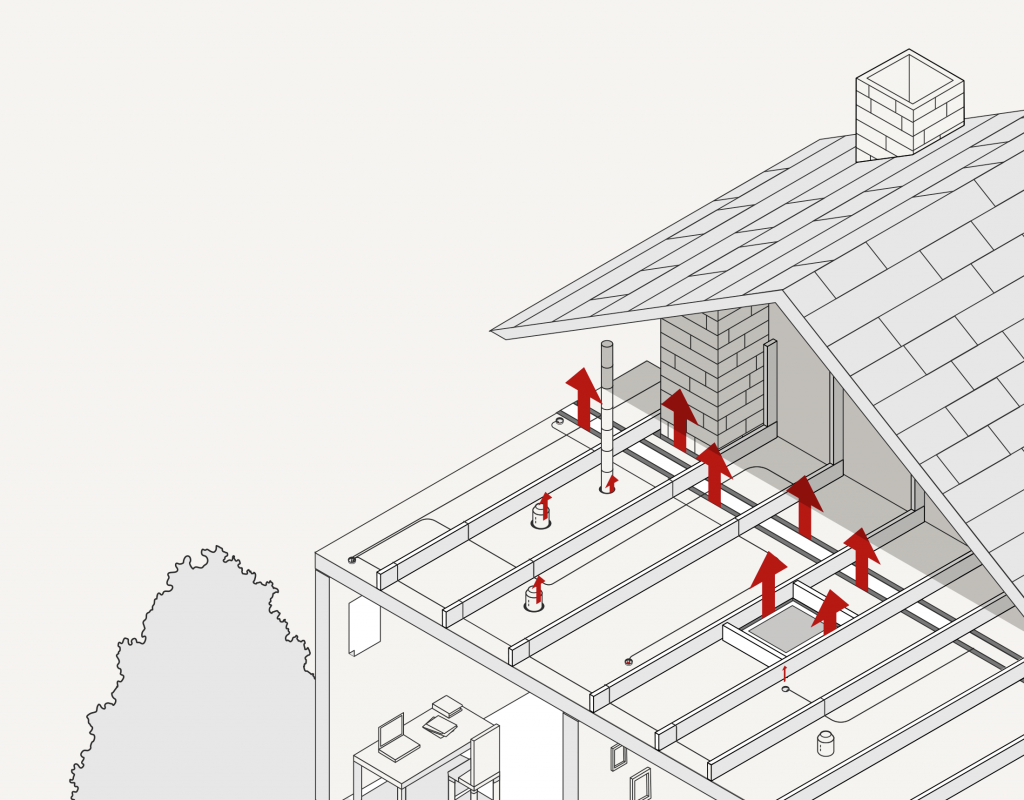
Hot air escapes through the attic
Every little opening in your house—especially in the attic—provides an opportunity for heated air to rise and escape up and out of the home.
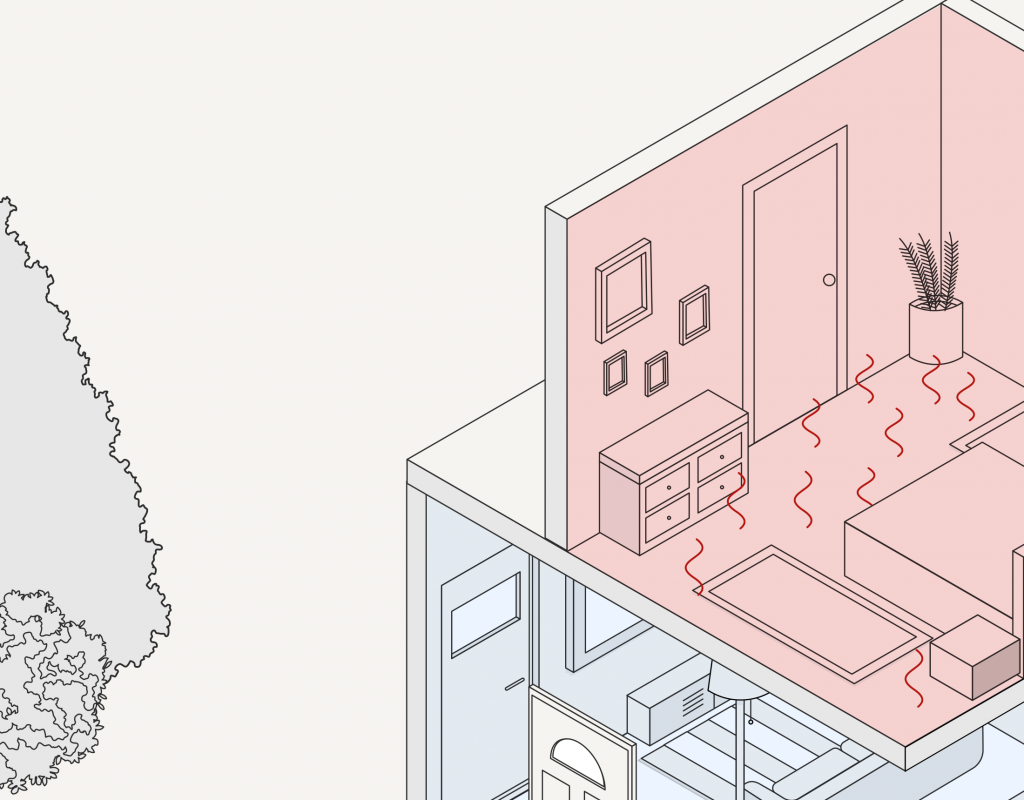
The rooms below the attic get hot
In winter, as hot air moves up to the second floor, the upstairs gets warmer than the floors below. In summer, hot air trapped in the attic radiates into the second floor, making your upstairs feel like a sauna.
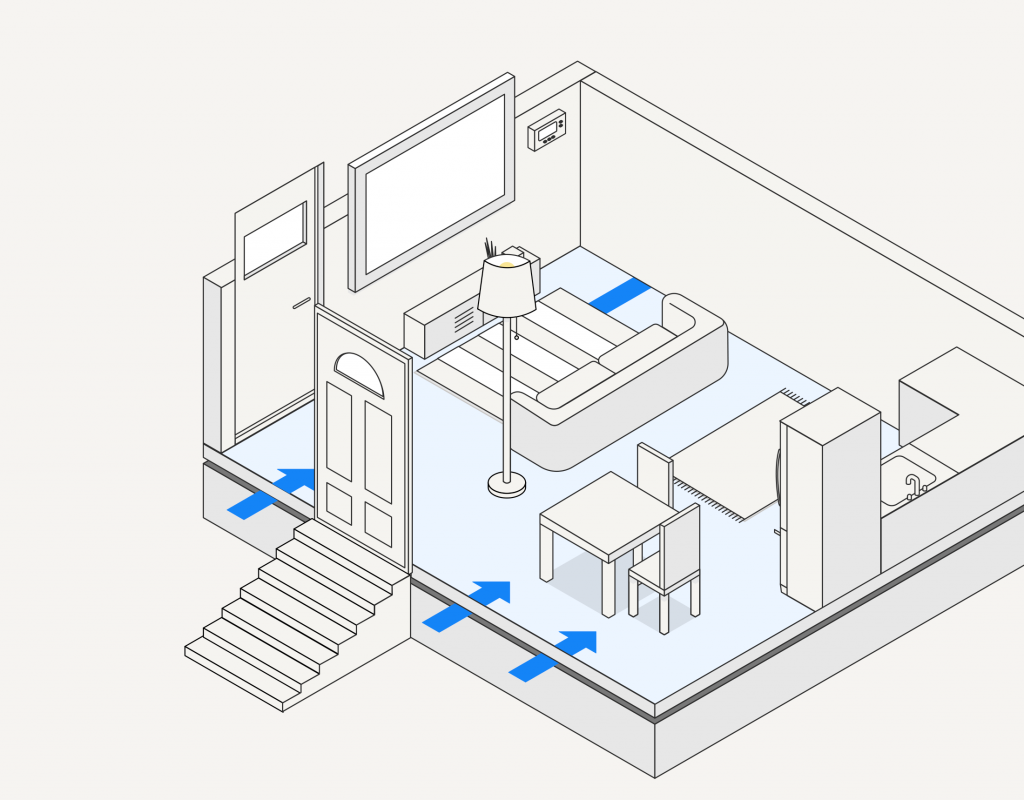
Cold air gets sucked in through the foundation
As heat rises, it creates a pressure vacuum that sucks cold air in from cracks and gaps at the foundation. For every unit of heated air that goes out of the house, a new unit of outside (cold!) air is drawn in.
Read How to fix cold floors to learn more.
And there it is—the giant vacuum effect (aka the stack effect) that makes your house feel cold and drafty.
You can actually feel this effect happening.
On the next cold day with no wind, try waving your hand around your doors, walls, and window until you find a burst of coolness.
Feel that steady stream of cold air coming in? It’s not being pushed in from the outside; instead, it’s being sucked in by the vacuum created by escaping warm air.
It’s important to note that cycling air isn’t a bad thing; any healthy home environment includes air movement of some kind, and you don’t want to completely seal off a home. (Learn more about air sealing and healthy airflow here.)
The problem is that your house is probably cycling air at 3 to 4 times the amount necessary, which makes it very difficult for even the best HVAC system to efficiently control the temperature. It also can have a negative effect on your home’s indoor air quality.
In any case, talking about vacuum cycling raises a few more questions:
- How does the vacuum effect begin?
- Why is all that hot air able to escape through the roof in the first place?
- Shouldn’t your ceilings trap it in?
Yes, your home should keep the warm air inside—but it probably doesn’t. (Read on.)
Your house shouldn’t feel like an igloo. To find out what igloo science and your house have in common, read How are igloos warm inside?
Houses are full of holes—and not just drafty old houses
Most houses just aren’t very airtight. Instead, they’re filled with little gaps, cracks, and holes.
And those gaps are everywhere—in the foundation, the walls, the attic, in your chimney, your attic entrance, your recessed lighting fixtures, the holes for wiring and plumbing. The list goes on.
All of these openings in the house—many so small you can barely see them—create pathways for air to travel through.
And when you add them all up, it’s like having a window wide open in your house. 24 hours a day, 365 days a year. That’s a big deal—a much bigger deal, in fact, than having older windows.
We call these holes that allow drafts inside air leaks. And you can even find these in your house yourself.
How to check for drafts in your house
Curious about how to find drafts in your house? You can detect drafty air leaks in your home through a few simple methods:
- Use a candle or incense as you walk around the house, paying attention to when and where the flame or line of smoke moves. Mark these spots with blue painter’s tape.
- Use your eyes to spot gaps and open seams along floorboards, windows, doors, and fixtures. If you see an open seam or gap, it’s likely it’s causing heat loss.
- Use a thermal leak detector to locate temperature differences around your house. (You’ll often detect these spots around the bottom of the doors in your house, outlets, windows, and more.)
For a detailed, step-by-step guide, read How to find air leaks in your house.
You can also get a professional energy audit (many local utilities offer them for free or at a low cost) to help locate trouble spots that are causing heat to escape.
How to fix a drafty house in 3 steps
So, what to do? How can you address a whole host of little problems that add up to the big problem of drafts?
Yes, you could replace your drafty windows.
But if you don’t also address all the tiny gaps in your home (and your under-insulated attic) it won’t solve the real problem.
The same goes for fixing leaky light fixtures and doors. The fact is that all of these smaller factors are part of a much broader ecosystem of issues, and you’ll need to address the whole picture if you want to solve the problem.
How do you address the whole issue? We’ve found the best solution is a combination of strategic insulation, air sealing, and ventilation.
Taken together, these upgrades help steady the flow of air through your house, bring the “giant vacuum” effect to a halt, and—most importantly—get rid of drafts for good.
Here’s what needs to happen—the big 3 steps that will solve your problem.
(And, FYI, you may be able to get all of this work done by professionals for no upfront cost.)
Cut up to 50% of your energy use with a combo of high-performance insulation, professional air sealing, and heat pump HVAC upgrades. Learn how.
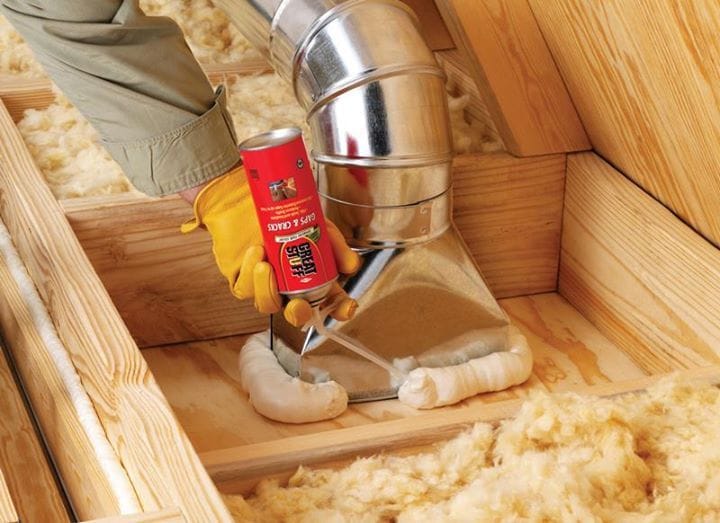
Step 1: Air seal your attic (and the rest of your house, too)
Stop excess air flow escaping through the attic by using foam to plug all of the little holes and cracks in the attic floor.
Air sealing your attic helps stop drafts by making it much harder for warm air to escape through the top of your home.
Air sealing is the process of finding and plugging all of the gaps, cracks, and crevices in your home.
It’s painstaking, methodical work—and it’s important to find the right professional to do it—but it can make a dramatic difference in how your home feels.
Learn more about air sealing here. Or, discover how you can work with Sealed to get your home completely air sealed… with an energy-savings guarantee.
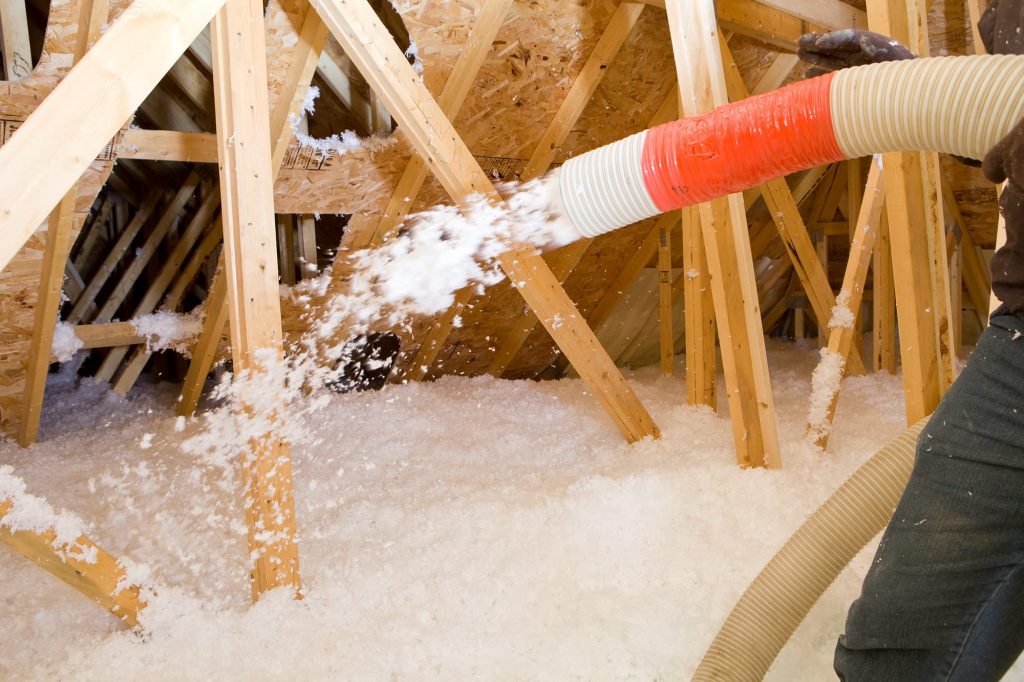
Step 2: Insulate your attic
Bring insulation thermal value up to R49 (about 15 inches of insulation), in accordance with U.S. Department of Energy standards.
The next crucial step is to properly insulate your attic (because the chances are good that your attic is either under-insulated or not insulated at all).
For most homes and situations, you’ll need to bring your insulation’s thermal value up to R-49 or greater—or about 15 inches of insulation.*
What’s R-value? Great question. Your insulation’s R-value is the measure of how efficient it is at stopping heat transfer. The higher the R-value, the more of a barrier your insulation will provide—and the better it will stop your heat from escaping through your roof.
And that’s exactly what you need to do if you want to bring drafts to a stop.
Questions about insulation or R-value? Check out our Complete Guide to Attic Insulation.
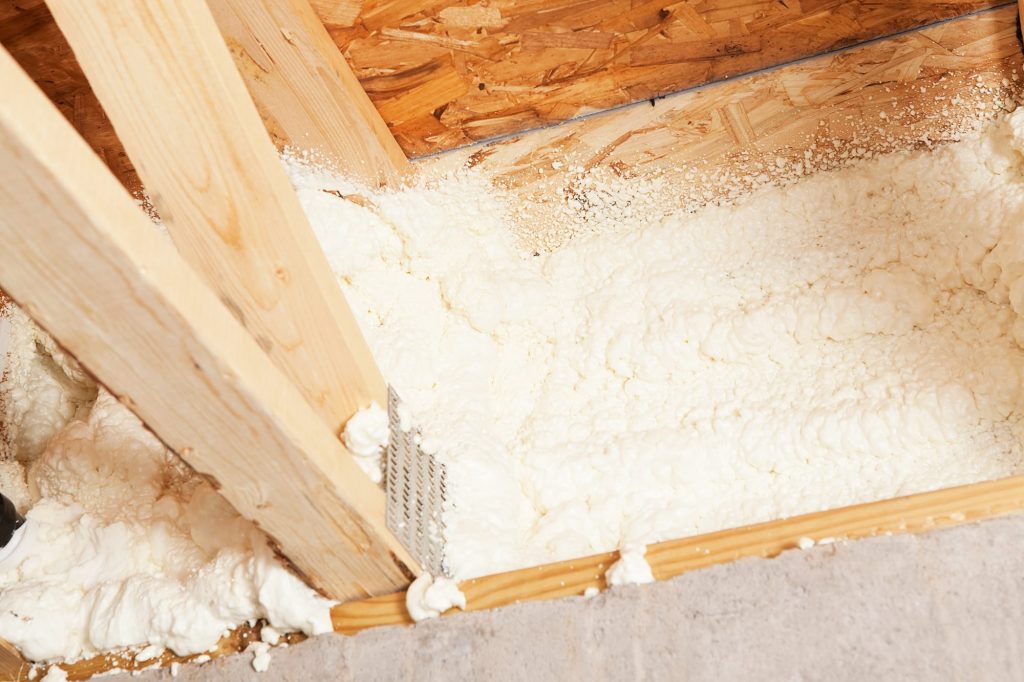
Step 3: Air seal and insulate your foundation
Use 2-part foam or foam board + sealant to air seal and insulate the wooden panel (called rim joist) where the foundation meets the structure of the house.
Finally, it’s time to address the place where most of the cold air is getting in—your foundation.
To do that, our professionals typically use 2-part foam (or foam board plus a sealant) to air seal and insulate the wooden panel where the foundation meets the structure of the house.
You’ll notice we said “professionals.” Properly air sealing a foundation (or any part of your home, really) is hard, dirty work and requires a detailed understanding of how air gets into and then cycles through a building. It isn’t a good DIY project.
For best results—and an actual solution to your draft problem—partner with qualified, trained air sealing professionals. (Which is what we’re about to talk about below.)
Quick solutions to keep an old, drafty house warm today
If you’re reading this and you need an easy, quick fix to stay warm in your drafty house, here are a few things you can do until you can get the needed air sealing and insulation work done.
- Create draft blockers for your windows and doors. Get more info in our guide How to stop drafty windows.
- Install insulated window treatments. Thermal curtains can help block drafts and trap in warmth when closed.
- Hang up old blankets over exterior doors. This seems old-fashioned, but hey, it can keep you cozy in a pinch!
- Add fresh weather-stripping to doors and windows. This is a fairly inexpensive, quick solution, and it works!
- Use bathroom and kitchen fans less frequently. If you can, turn off kitchen and bathroom fans immediately after use to keep from losing heat.
And while you’re planning your permanent fixes, make sure to look into Inflation Reduction Act tax credits for home upgrades and even local utility rebates that you could be eligible for.
Many energy-efficient home upgrades and draft-stopping weatherization improvements, like insulation and air sealing, can qualify for some federal, state, and local incentives.
How to get rid of drafts without emptying your bank account
The process to get rid of drafts is straightforward—but it isn’t easy. It requires hard work and specialized home weatherization expertise, so you’ll need to hire professionals and make a game plan.
The good news is that turning stubborn houses into unbelievably comfortable homes is our business.
We know how to fix your house, we know the right people to do it, and we can get the project done with a minimum of hassle to you.
And with the Sealed Comfort Plan, you can get this work done for no (or very little) upfront cost—you’ll pay for it with a flexible payment option that works best for you and your budget.
We stand by our work 100%, too. If you don’t save energy, we take the hit.
Sound interesting? Call us at 917-382-3729 to talk about your house. We’ll tell you if we can help (and if we can’t, we’re happy to give you advice or a lead elsewhere).
Ready to see if you qualify to get rid of drafts with Sealed at no upfront cost?